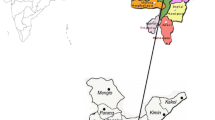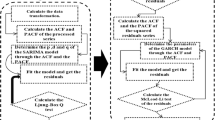Abstract
Rainfall forecasting models developed using the seasonal autoregressive integrated moving average (SARIMA) technique for spatially distributed rain gauge stations in the state of Kerala are presented in this paper. Monthly rainfall data for 113 years were considered to build models for 29 meteorological stations. As the time-series data span 11 decades, there is a high chance of non-stationarity, owing to the presence of trend and seasonality. The non-stationarities in the time-series datasets are assessed by applying the seasonal and trend decomposition using the Loess technique (STL) and Kwiatkowski–Phillips–Schmidt–Shin (KPSS) test. Prior to applying this procedure, preliminary analyses on the datasets are carried out to detect and fill the missing values, examining the properties of the time-series datasets, including the tests for detecting trend and seasonality. Out of 29 stations, the results of the Mann–Kendall trend test indicated that marginal trends were present only in the rainfall datasets belonging to two stations. The partial autocorrelation function (PACF) and autocorrelation function (ACF) plots of most of the stations showed strong seasonal autocorrelation. The developed SARIMA models also indicated that the influence of the seasonal components is dominant compared to non-seasonal components for most of the stations.
Research Highlights
-
The percentage of missing values in the precipitation time-series datasets ranged between 0.52% (at Thiruvananthapuram (O)) and 14.75% (at Irikkur) and were filled by applying the expectation–maximisation algorithm.
-
Shapiro–Wilk test and Kolmogorov–Smirnov test were applied to check for normality of the time series. It was found that all the stations were non-normally distributed.
-
Classical Mann–Kendall and Sen’s slope were applied to determine the magnitude and direction of the trend.
-
STL technique and KPSS test are applied to evaluate the stationarity behaviour in the meteorological time-series datasets.







Similar content being viewed by others
References
Allison P D 2002 Missing data: Quantitative applications in the social sciences; Sage Publications, London.
Cleveland R B, Cleveland W S, Jean E M and Terpenning I 1990 STL: A seasonal-trend decomposition procedure based on Loess; J. off. Stat. 6(1) 3–73.
Danandeh Mehr A, Hrnjica B, Bonacci O and Torabi Haghighi A 2021 Innovative and successive average trend analysis of temperature and precipitation in Osijek, Croatia; Theor. Appl. Climatol. 145(3–4) 875–890, https://doi.org/10.1007/s00704-021-03672-3.
Dash Y, Mishra S K and Panigrahi B K 2018 Rainfall prediction for the Kerala state of India using artificial intelligence approaches; Comput. Electr. Eng. 70 66–73, https://doi.org/10.1016/j.compeleceng.2018.06.004.
de Gois G, de Oliveira-Júnior J F, da Silva Junior C A, Sobral B S, de Bodas Terassi P M and Junior A H S L 2020 Statistical normality and homogeneity of a 71-year rainfall dataset for the state of Rio de Janeiro-Brazil; Theor. Appl. Climatol. 141(3) 1573–1591, https://doi.org/10.1007/s00704-020-03270-9.
Dempster A P, Laird N M and Rubin D B 1977 Maximum likelihood for incomplete data via the EM algorithm; J. R. Stat. Soc. Ser. B 39(1) 1–38.
Drisya J and Sathish Kumar D 2022 Evaluation of the drought management measures in a semi-arid agricultural watershed; Environ. Dev. Sustain., https://doi.org/10.1007/s10668-021-02079-4.
Drisya J, Kumar D S and Roshni T 2018 Spatiotemporal variability of soil moisture and drought estimation using a distributed hydrological model; Integrating Disaster Science and Management – Global Case Studies in Mitigation and Recovery, Elsevier Inc., pp. 451–460, https://doi.org/10.1016/B978-0-12-812056-9.00027-0.
Drisya J, Kumar D S and Roshni T 2021 Hydrological drought assessment through streamflow forecasting using wavelet enabled artificial neural networks; Environ. Dev. Sustain. 23(3) 3653–3672, https://doi.org/10.1007/s10668-020-00737-7.
Fang T and Lahdelma R 2016 Evaluation of a multiple linear regression model and SARIMA model in forecasting heat demand for district heating system; Appl. Energy 179 544–552, https://doi.org/10.1016/j.apenergy.2016.06.133.
Firat M, Dikbas F, Koç A C and Gungor M 2010 Missing data analysis and homogeneity test for Turkish precipitation series; Sadhana – Acad. Proc. Eng. Sci. 35(6) 707–720, https://doi.org/10.1007/s12046-010-0051-8.
Gilbert R O 1987 Statistical methods for environmental pollution monitoring; Wiley,Van Nostrand Reinhold, New York.
Graham A and Pathak Mishra E 2017 Time series analysis model to forecast rainfall for Allahabad region; J. Pharmacogn. Phytochem. 6(5) 1418–1421.
Hadi S J and Tombul M 2018 Long-term spatiotemporal trend analysis of precipitation and temperature over Turkey; Meteorol. Appl. 25(3) 445–455, https://doi.org/10.1002/met.1712.
Hyndman R J and Athanasopoulos G 2018 Forecasting: Principles and practice; Monash University, Australia, OTexts™, Melbourne.
Hyndman R J and Khandakar Y 2008 Automatic time series forecasting: The forecast package for R; J. Stat. Softw. 27(3) 1–42, https://doi.org/10.18637/jss.v027.i03.
Kabbilawsh P, Sathish Kumar D and Chithra N R 2020 Trend analysis and SARIMA forecasting of mean monthly maximum and minimum temperature data for the state of Kerala, India; Acta Geophys. 68(4) 1161–1174, https://doi.org/10.1007/s11600-020-00462-9.
Kabbilawsh P, Sathish Kumar D and Chithra N R 2021 Infilling missing monthly maximum and minimum temperature dataset by EM Algorithm followed by distribution based statistical assessment using eight absolute homogeneity tests; In: Climate Change Impacts on Water Resources, pp. 503–518, https://doi.org/10.1007/978-3-030-64202-0_43.
Kang H 2013 The prevention and handling of the missing data; Korean J. Anesthesiol., https://doi.org/10.4097/kjae.2013.64.5.402.
Kang B and Ramírez J A 2007 Response of streamflow to weather variability under climate change in the Colorado Rockies; J. Hydrol. Eng. 12(1) 63–72, https://doi.org/10.1061/(asce)1084-0699(2007)12:1(63).
Krishnakumar K N, Prasada Rao G S L H V and Gopakumar C S 2009 Rainfall trends in 20th century over Kerala, India; Atmos. Environ. 43(11) 1940–1944, https://doi.org/10.1016/j.atmosenv.2008.12.053.
Kwiatkowski D, Phillips P C B, Schmidt P and Shin Y 1992 Testing the null hypothesis of stationarity against the alternative of a unit root. How sure are we that economic time series have a unit root?; J. Econom. 54(1–3) 159–178, https://doi.org/10.1016/0304-4076(92)90104-Y.
Mallick J, Talukdar S, Alsubih M, Salam R, Ahmed M, Ben Kahla N and Shamimuzzaman M 2021 Analysing the trend of rainfall in Asir region of Saudi Arabia using the family of Mann–Kendall tests, innovative trend analysis, and detrended fluctuation analysis; Theor. Appl. Climatol. 143(1–2) 823–841, https://doi.org/10.1007/s00704-020-03448-1.
Mann H B 1945 Nonparametric tests against trend; Econometrica 13(3) 245, https://doi.org/10.2307/1907187.
Nair A, Ajith Joseph K and Nair K S 2014 Spatio-temporal analysis of rainfall trends over a maritime state (Kerala) of India during the last 100 years; Atmos. Environ. 88 123–132, https://doi.org/10.1016/j.atmosenv.2014.01.061.
Narayanan P, Basistha A, Sarkar S and Kamna S 2013 Trend analysis and ARIMA modelling of pre-monsoon rainfall data for western India; Comptes Rendus – Geosci. 345(1) 22–27, https://doi.org/10.1016/j.crte.2012.12.001.
Ng C K, Ng J L, Huang Y F, Xun T Y and Mirzaei M 2020 Tropical rainfall trend and stationarity analysis; Water Supply 20(7) 2471–2483, https://doi.org/10.2166/ws.2020.143.
Nikhil Raj P P and Azeez P A 2012 Trend analysis of rainfall in Bharathapuzha River basin, Kerala, India; Int. J. Climatol. 32(4) 533–539, https://doi.org/10.1002/joc.2283.
Nyikadzino B, Chitakira M and Muchuru S 2020 Rainfall and runoff trend analysis in the Limpopo river basin using the Mann–Kendall statistic; Phys. Chem. Earth, Parts A/B/C 117 102870, https://doi.org/10.1016/j.pce.2020.102870.
Radziejewski M and Kundzewicz Z W 2004 Detectability of changes in hydrological records; Hydrol. Sci. J. 49(1) 39–51, https://doi.org/10.1623/hysj.49.1.39.54002.
Romman Z A, Al-bakri J and Al Kuisi M 2019 Estimation of rainfall missing data in an arid area using spatial and EM methods; J. Eng. Res. Appl. 9(3) 76–80.
Rubin D B 1978 Multiple imputations in sample surveys – a phenomenological Bayesian approach to nonresponse; Proc. Surv. Res. Methods Sect. Am. Stat. Assoc., pp. 20–34.
Sahin S and Cigizoglu H K 2010 Homogeneity analysis of Turkish meteorological data set; Hydrol. Process. 24(8) 981–992, https://doi.org/10.1002/hyp.7534.
Salmi T, Maatta A, Anttila P, Ruoho-Airola T and Amnell T 2002 Detecting trends of annual values of atmospheric pollutants by the Mann–Kendall Test and Sen’s solpe estimates the excel template application MAKESENS; Finnish Meteorological Institute, Publications on Air Quality, No. 31, Helsinki, Finland.
Sen P K 1968 Estimates of the regression coefficient based on Kendall’s Tau; J. Am. Stat. Assoc. 63(324) 1379–1389.
Simon A and Mohankumar K 2004 Spatial variability and rainfall characteristics of Kerala; Proc. Indian Acad. Sci. Earth Planet. Sci. 113(2) 211–221, https://doi.org/10.1007/BF02709788.
Tirkey N, Parhi P K, Lohani A K and Chandniha S K 2021 Analysis of precipitation variability over Satluj Basin, Himachal Pradesh, India 1901–2013; J. Water Clim. Change 12(1) 127–135, https://doi.org/10.2166/wcc.2020.136.
Wang S, Feng J and Liu G 2013 Application of seasonal time series model in the precipitation forecast; Math. Comput. Model 58(3–4) 677–683, https://doi.org/10.1016/j.mcm.2011.10.034.
Wang H R, Wang C, Lin X and Kang J 2014 An improved ARIMA model for precipitation simulations; Nonlinear Process. Geophys. 21(6) 1159–1168, https://doi.org/10.5194/npg-21-1159-2014.
Acknowledgement
The authors would like to acknowledge the India Meteorological Department (IMD) for the precipitation datasets.
Author information
Authors and Affiliations
Contributions
Kabbilawsh Peruvazhuthi: Conceptualisation, methodology, software, validation, formal analysis, investigation, resources, data curation, writing – original draft, review and editing, visualisation, supervision, project administration. Sathish Kumar D: Formal analysis, investigation, writing – original draft, review and editing, visualisation, supervision. Chithra N R: Formal analysis, investigation, writing – original draft, review and editing, visualisation, supervision.
Corresponding author
Additional information
Communicated by C Gnanaseelan
Rights and permissions
About this article
Cite this article
Kabbilawsh, P., Kumar, D.S. & Chithra, N.R. Forecasting long-term monthly precipitation using SARIMA models. J Earth Syst Sci 131, 174 (2022). https://doi.org/10.1007/s12040-022-01927-9
Received:
Revised:
Accepted:
Published:
DOI: https://doi.org/10.1007/s12040-022-01927-9




